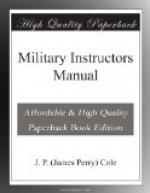See answer No. 4.
6. What is the composition and arrangement of the advance guard?
Ans.—All arms of the service. In open country much cavalry and field artillery, the latter seldom assigned to command smaller than a brigade. Also machine guns, ambulance company if the force is large and engineers for purpose of removing obstacles to the march.
Large command; advance cavalry, support, reserve.
Small command; point, advance party, support, reserve.
Strength should be 1/20 to 1/3, depending on size of command and character of terrain.
Advance guard increases in size proportionately with
size of command.
Why?
7. Define: (a) Outguard; they constitute small detachments farthest to the front and nearest to the enemy.
(b) Cossack post; observation group at indicated point consisting of four men, post single sentinel.
(c) Picket; small command up to platoon placed in line of outguards at more important points such as road forks.
8. What is an order?
Ans.—Orders are used by commanders of divisions and separate brigades for regulating the movement and supply of field trains, fixing position of distributing points for rations and forage, in short, have to do with supplies of all kinds, especially food.
Form:
The heading.
The distribution
of troops (in certain orders).
The body.
The ending.
The Body contains:
1. Information
about the enemy and our supporting troops.
2. General
plan of the commander.
3. Disposition
of the troops.
4. Instructions
for the trains.
5. Where
the commander may be found or messages are to be sent.
9. During an advance what is the general order of advance of a column?
Ans.—Cavalry and horse artillery.
Infantry
and light artillery.
Engineering
and signal troops.
Trains.
10. What is the average march per day of various arms?
Ans.—Infantry, 15 miles per day.
Infantry
in large bodies, 12 miles per day.
Cavalry,
25 miles per day.
Field
artillery, 15 to 20 miles per day.
Horse
artillery, same as cavalry, to which it may be attached.
Forced marches are from 28 to 30 miles for infantry.
11. How is the escort distributed in guarded convoys?
Ans.—Advance guard, with advance cavalry 3 to 5 miles ahead.
Main body may be opposite most important point of the train, usually opposite its center.
Section of infantry at head and tail of train.
Flank guard—if necessary.
Rear guard—1/6 of escort.
What places are most favorable for attacking convoy?
When passing through woods, defile, or over bridge, when going around sharp bends in the road; when convoy is forming corral.




